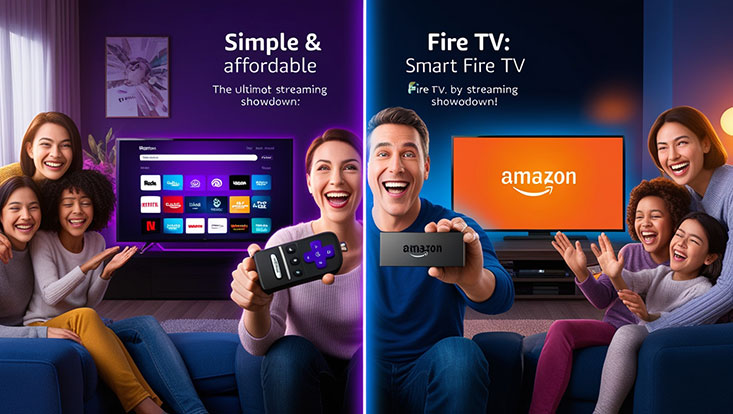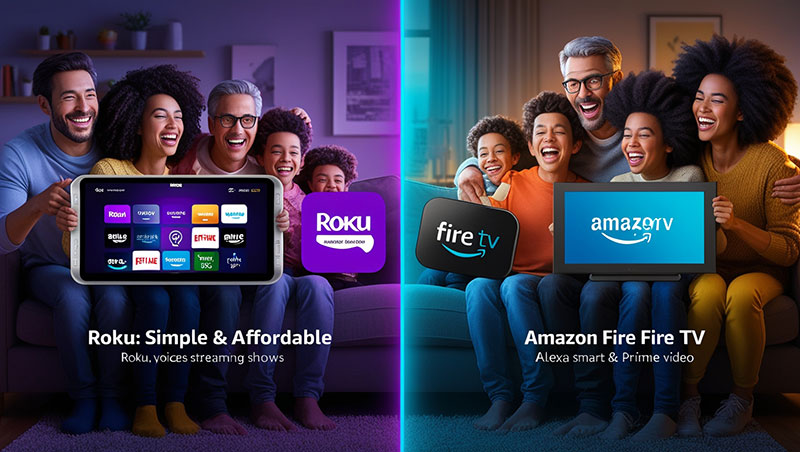Roku vs. Fire TV: Unleash Epic Streaming Glory
In the ever-evolving world of streaming entertainment, choosing the right device can make or break your viewing experience. Two of the biggest players in the game—Roku and Amazon Fire TV—consistently top the charts for their affordability, versatility, and performance. But which one truly deserves the crown? In this in-depth comparison of Roku vs. Amazon Fire TV, we’ll break down their features, performance, pricing, and more to help you decide which streaming device reigns supreme for your needs in 2025.
What Are Roku and Amazon Fire TV?
Before diving into the showdown, let’s get a quick overview of these streaming giants:
- Roku: A pioneer in the streaming world, Roku offers a range of devices (from sticks to smart TVs) known for their user-friendly interface and vast app ecosystem. It’s a neutral platform, meaning it doesn’t push one streaming service over another.
- Amazon Fire TV: Backed by Amazon, Fire TV integrates seamlessly with the Amazon ecosystem (think Prime Video and Alexa) and offers powerful hardware options, from budget-friendly sticks to premium cubes.
Both devices aim to deliver your favorite shows, movies, and apps—but how do they stack up? Let’s explore.
Top Recommendation:
Discover the ultimate entertainment solution with 7 Days GenIPTVPro Subscription, designed just for you.
Roku vs. Amazon Fire TV: Key Features Compared

1. User Interface and Ease of Use
- Roku: Roku’s interface is clean, simple, and intuitive. It prioritizes neutrality, giving equal billing to apps like Netflix, Hulu, and Disney+ without favoring any single service. The home screen is customizable, letting you arrange apps to your liking.
- Amazon Fire TV: Fire TV’s interface is sleek but heavily skewed toward Amazon content. Prime Video and other Amazon-owned services take center stage, which can feel cluttered if you’re not an Amazon loyalist. However, Alexa integration makes voice navigation a breeze.
Winner: Roku for its unbiased and straightforward design; Fire TV if you love Amazon’s ecosystem.
2. Content and App Availability
Both platforms support major streaming apps like Netflix, Hulu, YouTube, and Disney+, but there are differences:
- Roku: Boasts over 10,000 apps and channels, including free content via The Roku Channel. It’s a haven for cord-cutters seeking variety.
- Amazon Fire TV: Matches Roku’s app library but shines with Amazon exclusives and Prime Video perks. However, it occasionally lags in supporting niche or newer apps.
Winner: Tie—both offer robust libraries, though Roku edges out for free content options.
3. Hardware and Performance
- Roku: Models range from the budget-friendly Roku Express ($29.99) to the high-end Roku Ultra ($99.99). The Ultra supports 4K, HDR, and Dolby Vision for a premium experience.
- Amazon Fire TV: Options include the Fire TV Stick Lite ($29.99) and the Fire TV Cube ($119.99). The Cube doubles as an Alexa smart speaker and delivers 4K Ultra HD with Dolby Atmos.
Winner: Fire TV for raw power and smart home integration; Roku for cost-effective variety.
4. Voice Control and Smart Features
- Roku: Voice control is available on higher-end models via the Roku Voice Remote. It’s functional but lacks the sophistication of Alexa.
- Amazon Fire TV: Alexa is the star here. Use voice commands to search, control playback, or manage smart home devices—a huge plus for Amazon fans.
Winner: Fire TV, hands down, for its advanced voice capabilities.
5. Pricing and Value
- Roku: Starts at $29.99 and scales up to $99.99. It’s budget-friendly with no subscription required.
- Amazon Fire TV: Also starts at $29.99, but premium models like the Cube push the price higher. Prime membership ($14.99/month) enhances value for Amazon users.
Winner: Roku for affordability; Fire TV for Prime subscribers.
Roku vs. Amazon Fire TV: Pros and Cons
Roku
Pros:
- Simple, neutral interface
- Affordable options for all budgets
- Extensive free content via The Roku Channel
Cons:
- Voice control is basic
- No deep smart home integration
Amazon Fire TV
Pros:
- Seamless Alexa integration
- Powerful hardware for 4K streaming
- Ideal for Amazon Prime members
Cons:
- Biased toward Amazon services
- Slightly pricier premium models
Which Device Is Right for You?
- Choose Roku if: You want an affordable, easy-to-use device with no ecosystem bias. It’s perfect for cord-cutters and casual streamers who value simplicity and variety.
- Choose Amazon Fire TV if: You’re invested in Amazon’s ecosystem, crave advanced voice control, or want a device that doubles as a smart home hub.
Final Verdict: Roku vs. Amazon Fire TV in 2025
So, which streaming device reigns supreme? It depends on your priorities:
- For versatility and value, Roku takes the lead with its neutral platform and budget-friendly options.
- For smart features and performance, Amazon Fire TV wins with Alexa and premium hardware.
FAQ

1. What’s the main difference between Roku and Amazon Fire TV?
Roku offers a neutral, user-friendly platform with no bias toward specific services, while Amazon Fire TV integrates deeply with Amazon’s ecosystem, prioritizing Prime Video and Alexa features.
2. Which is better for 4K streaming, Roku or Amazon Fire TV?
Both support 4K, but Amazon Fire TV’s premium models (like the Fire TV Cube) edge out with Dolby Atmos and faster performance, while Roku Ultra offers solid 4K with Dolby Vision at a lower price.
3. Can I get free content on Roku and Amazon Fire TV?
Yes! Roku provides free movies and shows via The Roku Channel, while Fire TV offers free content for Prime members and limited ad-supported options through IMDb TV.
4. Does Roku or Amazon Fire TV work better with smart home devices?
Amazon Fire TV wins here, thanks to Alexa integration, which lets you control smart home devices. Roku lacks robust smart home features.
5. Which streaming device is more affordable?
Both start at $29.99, but Roku offers better value for non-Prime users, while Fire TV’s higher-end models (up to $119.99) appeal to Amazon loyalists seeking premium features.
Ultimately, both Roku and Amazon Fire TV are champions in their own right. Assess your streaming habits, budget, and ecosystem preferences to crown your personal winner. Ready to cut the cord? Either way, you’re in for a stellar streaming experience in 2025!
